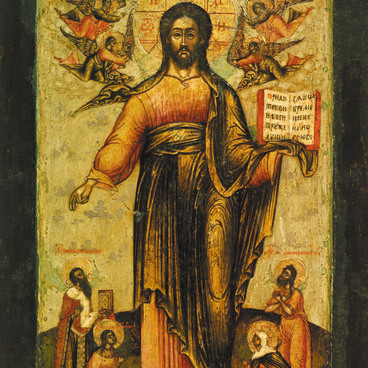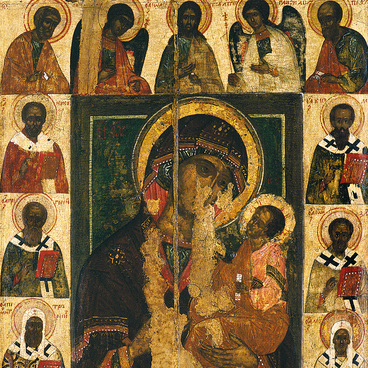The icon of Christ Pantocrator is the most common depiction of Jesus. This title is often used to refer to Jesus as the Heavenly King and Judge in the Old and New Testament, including such books as the Book of Psalms, the Book of Baruch, the Third Book of Maccabees, the Second Epistle to the Corinthians by Paul the Apostle, and the Revelation to John.
The oldest icon of the Pantocrator style dates from the mid-6th century. It is the Christ Pantocrator of St. Catherine’s Monastery at Sinai. There are various versions of this image which is used in full-length, half-length, chest-length, and throne icons. It can be seen in individual icons, in the Deesis row, and wall paintings. In the Orthodox tradition, it is usually depicted on the inner side of the central dome.
In the history of Yaroslavl icon painting, this image holds special significance as the oldest local monument of art. It was the family icon of the first Yaroslavl Prince Vsevolod who died in the Battle of the Sit River in 1238, and his sons Vasily and Konstantin who were canonized in the early 16th century. Most likely, the popular name of the icon “the Vasilyok Pantocrator” was given to this icon after Prince Vasily.
This icon originally belonged to the Cathedral of the Dormition in Yaroslavl. In his 1860 work “The Churches and Archaeology of the City of Yaroslavl”, Apollinary Krylov (1834–1912), a priest’s son, a local historian, and an important public figure, mentioned the relics related to the Saint Princes Konstantin and Vasily. These included a silver reliquary with the remains of the princes and three icons that used to be placed on the columns of the cathedral: Our Lady of Yaroslavl, the Savior, and Nicholas the Wonderworker. In his 1879 monograph “The Cathedral of the Dormition in Yaroslavl”, Professor Aleksey Lebedev commented that the ancient richly decorated icon of the Savior was placed in the kiot to the right of the large icon of the Saint Princes Vasily and Konstantin, on the western side of the south-eastern column. Another important reference to this icon can be found in the letters of Igor Grabar written during his research trips to old Russian cities.
The All-Russian Commission for the Research and Conservation of Old Russian Painting, founded and headed by Igor Grabar, helped to determine the global significance of this Pantocrator icon as a monument of art. This is one of the few Russian icons and the only Yaroslavl icon which dates back to the period before the Mongol invasion and has been preserved to this day. Compared to other images of its time, the icon is characterized by exquisite lyricism.
The oldest icon of the Pantocrator style dates from the mid-6th century. It is the Christ Pantocrator of St. Catherine’s Monastery at Sinai. There are various versions of this image which is used in full-length, half-length, chest-length, and throne icons. It can be seen in individual icons, in the Deesis row, and wall paintings. In the Orthodox tradition, it is usually depicted on the inner side of the central dome.
In the history of Yaroslavl icon painting, this image holds special significance as the oldest local monument of art. It was the family icon of the first Yaroslavl Prince Vsevolod who died in the Battle of the Sit River in 1238, and his sons Vasily and Konstantin who were canonized in the early 16th century. Most likely, the popular name of the icon “the Vasilyok Pantocrator” was given to this icon after Prince Vasily.
This icon originally belonged to the Cathedral of the Dormition in Yaroslavl. In his 1860 work “The Churches and Archaeology of the City of Yaroslavl”, Apollinary Krylov (1834–1912), a priest’s son, a local historian, and an important public figure, mentioned the relics related to the Saint Princes Konstantin and Vasily. These included a silver reliquary with the remains of the princes and three icons that used to be placed on the columns of the cathedral: Our Lady of Yaroslavl, the Savior, and Nicholas the Wonderworker. In his 1879 monograph “The Cathedral of the Dormition in Yaroslavl”, Professor Aleksey Lebedev commented that the ancient richly decorated icon of the Savior was placed in the kiot to the right of the large icon of the Saint Princes Vasily and Konstantin, on the western side of the south-eastern column. Another important reference to this icon can be found in the letters of Igor Grabar written during his research trips to old Russian cities.
The All-Russian Commission for the Research and Conservation of Old Russian Painting, founded and headed by Igor Grabar, helped to determine the global significance of this Pantocrator icon as a monument of art. This is one of the few Russian icons and the only Yaroslavl icon which dates back to the period before the Mongol invasion and has been preserved to this day. Compared to other images of its time, the icon is characterized by exquisite lyricism.



